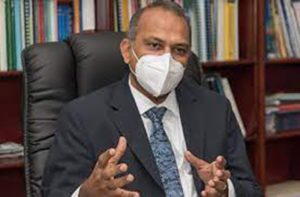–as authorities pursue aggressive drainage response
FLOODWATER is beginning to recede in most of the affected communities across Guyana, according to Agriculture Minister Zulfikar Mustapha.
He told the Guyana Chronicle on Thursday that more water pumps have been installed, while an around-the-clock drainage support system has been up and running to minimise the devastating effects of continued rainfall.
It has been more than two weeks since the May-June rains began to wreak havoc, devastating a number of communities across Guyana. The government immediately shifted gear and began rolling out a massive response effort. This has so far seen the deployment of equipment countrywide to conduct emergency cleaning and clearing of drains and canals; the installation of a number of new water pumps and drainage tubes; the dredging and excavation of clogged waterways, and continuous repairs to breaches and damaged infrastructure.

Minister Mustapha, who has been on the ground since the flood started, said that even though the water levels have dropped, some communities are still heavily affected, communities such as Black Bush Polder, in Region Six (East Berbice-Corentyne); Mahaicony Creek, in Region Five (Demerara-Mahaica); and Kwakwani, way up in Region Ten (Upper Demerara-Berbice), where flood waters have surpassed 12 feet. Emergency response teams have been dispatched to these heavily-affected areas to address the needs of residents.
The Ministry of Agriculture’s team has been paying keen attention to drainage, as well as the agricultural needs of farmers who want to keep livestock and other supplies dry and safe. Assistance is also being provided for the removal of products from farmlands, using heavy-duty machinery.
The Agriculture Ministry has also been issuing seeds, cuttings, cassava sticks and Fastac to those who have been able to move to higher ground. Minister Mustapha expressed hope that the countrywide interventions would see water levels receding even more within the next 24 hours.
MORE RAIN
Meanwhile, Head of Climatology at the ‘Hydromet’ Office, Mr. Khomalchand Dhiram has said that the transition out of the rainy season has been known to occur during mid-July.
“All the way into July, as we transition out of the rainy season into the dry season, it will be wet,” Chand said during an interview on the National Communications Network (NCN).
His colleague, Chief ‘Hydromet’ Officer, Dr. Garvin Cummings related that unlike the 2005 floods, severe weather conditions have so far not been isolated to any particular geographical space.
“Note that we are just starting in June, so the rainy season is now peaking,” Dr. Cummings said.
He noted that so far, the Hydromet Office has found it challenging to not only effectively communicate the amount of rainfall, but its impact. He said, however, that the government has invested in initiatives that have boosted the Hyrdomet Office’s forecast capabilities.
In addition to data collection and drainage interventions, the Government of Guyana has also moved aggressively towards distributing flood-relief supplies to affected families, and those who have relocated to government shelters.
MEDICAL HAMPERS
With thousands of food and sanitary supply hampers already distributed, the Ministry of Health will now be moving to package medical goods that will further ensure the safety and well-being of those affected by the flood waters.
Minister of Health, Dr Frank Anthony said Thursday that based on the instructions of President Dr. Irfaan Ali, his ministry will be working towards preparing “medical hampers”, which will be added to the distribution efforts currently being spearheaded by the Civil Defence Commission (CDC), in partnership with the Guyana Defence Force (GDF) and a number of civilian volunteers.
“We will package things like Oral Rehydration Salts (ORS), ointments to deal with rashes, and a number of over-the-counter products… They would all come with clear instructions,” Dr. Anthony said.
He noted that the distribution of these items seeks to prevent the outbreak of diseases that are commonly associated with flooding.
Dr. Anthony told this publication that fortunately, the floods have not yet resulted in any outbreaks of any diarrheal or waterborne disease.
“As of now, we haven’t seen anything, but that doesn’t mean that we might not get anything,” Dr. Anthony posited.
Former Minister of Health, Dr. Leslie Ramsammy, who is the Adviser to the Ministry of Health, had said that based on the lessons learnt from the infamous 2005 floods, Guyana’s health system is better prepared to deal with any health implications that are likely to arise.
Dr. Anthony has assured persons that the Ministry of Health is on the lookout for any changes in disease patterns, including leptospirosis, which resulted in the loss of many lives during the 2005 floods.
As Guyana continues to battle the deadly coronavirus pandemic, Dr. Anthony said that all government shelters have been operating under strict COVID-19 protocols, so as to prevent any transmission of the disease. He said that so far, the CDC has not reported any changes that could indicate serious health concerns.
Since the floods began, President Ali has said that his government’s priority at this time is ensuring the safety and well-being of all Guyanese, particularly those who have suffered as a result of the floods. The CDC has reported that so far, in excess of 6,900 households have been affected.




.png)









